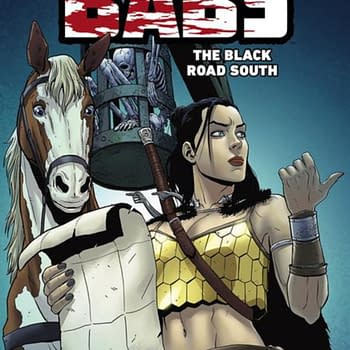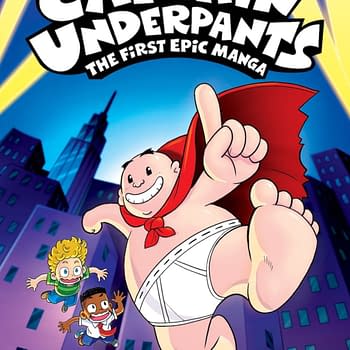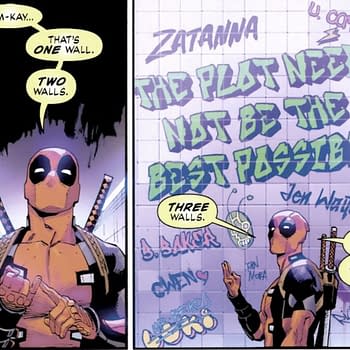Posted in: Comics | Tagged: adi tantimedh, Comics
Look! It Moves! by Adi Tantimedh: Bakuman – A Manga Industry Time Capsule
Adi Tantimedh writes for Bleeding Cool;
I read the news that BAKUMAN would be ending this week. The final chapter will be published in Japan's WEEKLY SHONEN JUMP and two weeks later in English in Viz Media's weekly SHONEN JUMP ALPHA e-anthology. That will bring the collected volumes to a total of 17 or 18, so the series will enjoy a second life as trades coming out for the next year or so in Asia and the West. BAKUMAN follows manga artist Mashiro Moritaka and his writing partner Takagi Akito as they progress from aspiring comics creators at the end of high school to Bright Young Newcomers to established-but-struggling pros and finally their twenties where they arrive with a top-selling series with an anime adaptation.
I call BAKUMAN a time capsule for the Japanese comics industry as it is now because it is filled with insider details about how the industry works. For instance, I didn't know until I read BAKUMAN that manga writers do not write scripts but actually draw basic page breakdowns for how each page would look before the artist starts to draw the story. There's a lot of comedy based on the social gatherings of manga creators and the anxieties and neuroses they suffer. There's a more detailed look at the editorial process in a comics publisher than I've ever seen anywhere. Most of all, BAKUMAN emphasizes that talent is not enough to survive in the industry if it's not coupled with persistence and a work ethic to keep going, especially in the face of rejection, disappointment and creative compromises.
Manga about manga artists and the industry have been well-represented with YoshIhiro Tatsumi's autobiographical A DRIFTING LIFE, which covered the origin and evolution of the manga industry after the Second World War, Hiroyuki's recent gag series DOUJIN WORK, about a band of teenagers who form a group to create their own manga to sell at Comiket, and GENSHIKEN, about a female college doujin club, and several other titles not translated into English. What makes BAKUMAN unique is its insider look at the current manga industry and how it works. Comedy and romantic view aside, it not only covers the ins and outs of the manga industry, how manga are created, how editors work with creators and how the publishers interact with fandom, practically a how-to lesson for aspiring mangaka on how to enter and stay in the industry. Most of all, it addresses the state of the industry in the age of the internet, media tie-in deals and social networking. It asks whether crowdsourced stories have any real artistic integrity (answer: it doesn't! And anyone who tries to cash in on crowdsourced work is not a good guy).
BAKUMAN is also very meta in the way it references real stories in the industry: a storyline where Mashiro, as a result of overwork and stress, ended up in hospital with liver failure seemed to reference what happened to the writer of the superpower manga ALIVE: THE FINAL EVOLUTION. ALIVE's writer, Tadashi Kawashima ended up with liver cancer and wrote the final chapters of the series from his hospital bed, shortly after which he passed away. The lives of many Japanese comics creators are stressful and hectic, with the need to meet often weekly deadlines, resulting in overwork, lack of sleep, bad diet and lack of exercise, and I was rather shocked when an editor told me that the average life expectancy of a Japanese comics artist is forty-four. A couple of years ago, I was taken aback to realise that the writer-artists of three top-selling manga had to put their work on hiatus due to ill health. Moyocco Anno (also the wife of EVANGELION creator and director Hideaki Anno) had to stop work on her comedy-drama series about a workaholic female magazine writer HATARAKI MAN, which had major merchandise tie-ins, an anime series and a live action TV series, and still has not resumed work on the manga series to this day. Takehiko Inoue had to stop work on VAGABOND, his ambitious, metaphysical retelling of the life of samurai Miyamoto Musashi, and has finally resumed work on what should be the final arc of the series this year. Ai Yazawa had to suspend work on her hugely popular Shoujo series about female friendship and the pop music industry NANA back in 2008 while the plot was reaching a climax, and still has not returned to the series. These creators were not newbies to the industry but veterans who had paid their dues with more than ten years' worth of work on other series, including at least one previous series that were hits, before they began work on these current – bigger – hits.
BAKUMAN also seems to be Ohba and Obata's own dialogue with what's happened in their own careers. Mashiro and Takagi's decision to end their popular supernatural thriller manga while ahead rather than find ways to prolong the series for the sake of sales and its upcoming anime series seems to be Ohba and Obata addressing what happened with their last hit series DEATH NOTE where the story appeared to be heading to a conclusion around volume 7 only for a plot twist to take place in order for the series to continue for another couple of years due to the series' sheer popularity and the launch of its even more popular anime series (I suspect the original intended ending might be the one used in the live action 2-part movie that was released a few years ago).
What's striking to me about BAKUMAN is its portrayal of the Japanese comics industry as fully-functioning infrastructure where all its members work hard to support and sustain each other and thus the industry as a whole, an industry engaged with fans and listens to feedback to keep things fresh and evolving. That might also say more about the sense of social cohesion in Japanese society than anything else. Granted, it's clearly a romantic view and love letter to the industry as the darker aspects of the industry are often glossed over, personal grudges are nonexistent in the series while they surely must exist in real life, and any real malice and vindictiveness comes from faceless trolls and haters on internet forums who want to destroy and hate out of envy. Another thing the series does not address is that overall comics sales are declining even in Japan, but that decline is nowhere as drastic as US comics sales, and manga still sell in the millions in Japan and tens of millions worldwide as opposed to the dwindling few hundred thousands in the US.
I have a chip on my shoulder about the manga industry getting right a lt of things the US industry is still struggling to get right, like focusing on creating good comics for a healthy reading market rather than publishing comics for the sake of maintaining IP franchise libraries that can be exploited for potential Hollywood hit movies, but what BAKUMAN dramatizes is how and why Japan's is a self-sustaining and functional industry more than the US industry has been. Aside from that, it's also a kind of manifesto for how artists and editors should work together to create great commercial comics. Anyone who wants to know about how comics are produced and how comics creators think should read BAKUMAN.
Looking at manga with big, shiny eyes at lookitmoves@gmail.com
Follow the official LOOK! IT MOVES! twitter feed at http://twitter.com/lookitmoves for thoughts and snark on media and pop culture, stuff for future columns and stuff I may never spend a whole column writing about.
Look! It Moves! © Adisakdi Tantimedh















